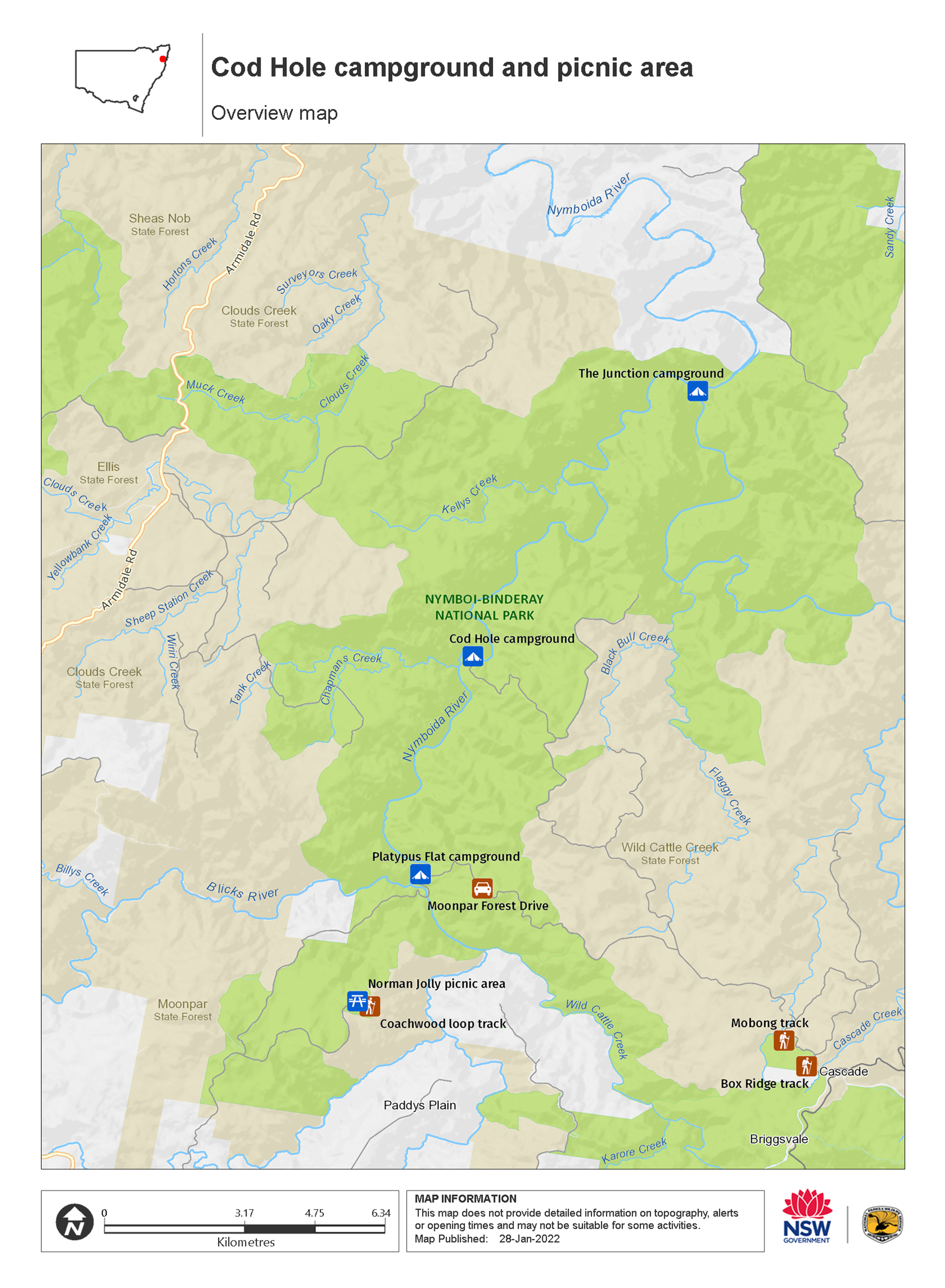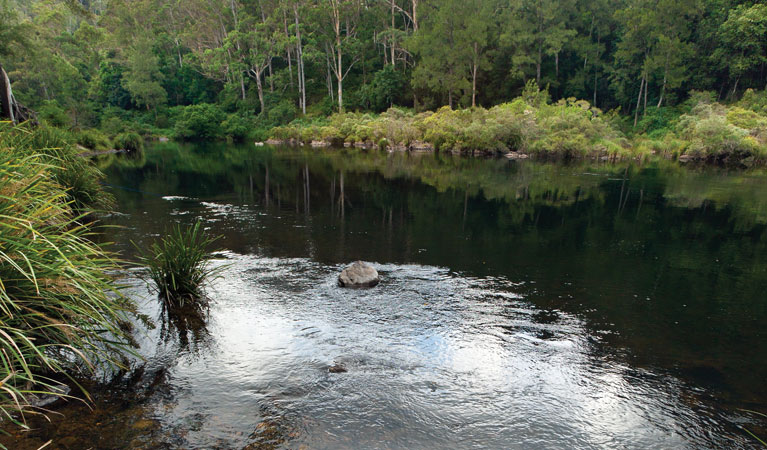Overview
Cod Hole campground offers the chance for remote riverside camping with excellent swimming and paddling, deep in the heart of Nymboi-Binderay National Park.
| Number of campsites | 6 |
|---|---|
| Camping type | Tent, Don't mind a short walk to tent |
| Facilities | Toilets, unpowered sites, marked sites, barbecue facilities, picnic tables, boat ramp, carpark |
| What to bring | Drinking water, cooking water, firewood |
| Bookings | Book up to 10 people or 2 sites online. |
| Group bookings | School groups and Park Eco Pass holders can make a group booking enquiry. |
| Please note |
|
For a remote wilderness adventure deep in the heart of Nymboi-Binderay National Park on the Dorrigo plateau, head for Cod Hole campground and picnic area. This rustic camping spot offers the chance to really get away from it all, in magnificent wild river country, surrounded by lush forests.
Settle in to your campsite before heading to the river for a range of water-based activities. This river is best known for whitewater so rafting is a great way to explore. When the river is calm, head in for a swim.
Nymboi-Binderay is the Aboriginal name for ‘The mighty river’, and the local Gumbaynggirr People would paddle these waters. Scarred trees, where canoes were carved from the trunks, are dotted throughout the park.
As night settles in, cook up a storm over the fire. If you’re curious to meet the neighbours, grab a torch for the chance to see sugar gliders, spotted quolls and bettongs.
Map

Map legend

Local alerts
For the latest updates on fires, closures and other alerts in this area, see https://www.nationalparks.nsw.gov.au/camping-and-accommodation/campgrounds/cod-hole-campground-and-picnic-area/local-alerts
Bookings
- National Parks Contact Centre
- 7am to 7pm daily
- 1300 072 757 (13000 PARKS) for the cost of a local call within Australia excluding mobiles
- parks.info@environment.nsw.gov.au
Operated by
- Coffs Harbour office
- Monday to Friday, 8.30am to 4.30pm.
- 02 6652 0900
- npws.coffscoast@environment.nsw.gov.au
- 4/32 Edgar St, Coffs Harbour NSW 2450
Park info
- in Nymboi-Binderay National Park in the North Coast region
Nymboi-Binderay National Park is always open but may have to close at times due to poor weather or fire danger.
Visitor info
All the practical information you need to know about the Cod Hole campground and picnic area.
Getting there and parking
Cod Hole campground and picnic area is in the central precinct of Nymboi-Binderay National Park. To get there from Dorrigo:
- Drive along Tyringham Road and turn right onto Moonpar Forest Drive
- After 24km, turn left onto Moses Rock Road and left again onto Cod Hole Road.
Alternatively:
- Take Megan Road from Dorrigo
- Turn left at Cascade into Moses Rock Road
- Turn left again onto Cod Hole Road
Road quality
- This access roads to this campground are not suitable for caravans
- Access roads are 4WD recommended
- Check the weather before you set out as the road to Cod Hole campground can become boggy when it rains.
- Unsealed roads
Vehicle access
- All roads require 4WD vehicle
Parking
Parking is available at Cod Hole campground and picnic area.
Best times to visit
There are lots of great things waiting for you in Nymboi-Binderay National Park. One of the highlights of a visit to the park is a whitewater rafting trip down the Nymboida River. Spring is a great time to head out on a guided tour.
Weather, temperature and rainfall
Summer temperature
Average
18°C and 29°C
Winter temperature
Average
5°C and 20°C
Rainfall
Wettest month
March
Driest month
August
The area’s highest recorded rainfall in one day
388mm
Facilities
Water is not available at this campground.
Toilets
- Non-flush toilets
Types of sites
- Unpowered sites
- Marked sites
Barbecue facilities
- Fire rings (bring your own firewood)
Picnic tables
Boat ramp
Carpark
Maps and downloads
Permitted
Fishing
A current NSW recreational fishing licence is required when fishing in all waters.
Prohibited
Gathering firewood
Generators
Pets
Pets and domestic animals (other than certified assistance animals) are not permitted. Find out which regional parks allow dog walking and see the pets in parks policy for more information.
Smoking
NSW national parks are no smoking areas.
Learn more
Cod Hole campground and picnic area is in Nymboi-Binderay National Park. Here are just some of the reasons why this park is special:
Ancient connections

Nymboi-Binderay National Park is the traditional Country of the Gumbaynggirr People and their ancient connection to this land is evident throughout the park. The park's landscape provided a rich source of food, medicine and shelter for Aboriginal people and features strongly in cultural knowledge and Dreaming stories. As you travel through this park, take some time to think about the people who lived here and their strong attachment to this ancient landscape and all it contains.
Animal kingdom

Nymboi-Binderlay has a diverse range of animals, including 68 types of mammal, 25 kinds of amphibian, 33 sorts of reptile and over 120 bird species; of these, at least 15 species are threatened. When you’re picnicking, camping or walking through the tallowwood and coachwood rainforests, be sure to keep your eyes open for the many native animals which call this place home.
- Moonpar Forest drive Moonpar Forest drive is a 75km scenic car touring route near Dorrigo. It’s a great day out and an ideal way to explore the walks, riverside picnic spots, and sights of Nymboi-Binderay and Cascade national parks.
- Norman Jolly picnic area Enjoy a picnic among tall old-growth trees and historic logging relics at Norman Jolly picnic area in Nymboi-Binderay National Park, not far from Dorrigo.
Waterworld

The Nymbodia River is a true highlight of Nymboi-Binderay National Park. The name of the park comes from Aboriginal language of the local Gumbaynggirr People; 'Nymboi' being their name for the river, and 'Binderay' meaning river. Rafting down the Nymboi River with an expert guide is an exhilarating experience and a fantastic way to take in the park's landscape.
- Coachwood loop track The Coachwood loop track is a short and easy walk that starts and finishes at the Norman Jolly picnic area in Nymboi-Binderay National Park.
- Moonpar Forest drive Moonpar Forest drive is a 75km scenic car touring route near Dorrigo. It’s a great day out and an ideal way to explore the walks, riverside picnic spots, and sights of Nymboi-Binderay and Cascade national parks.
Plants and animals protected in this park
Animals
-

Koala (Phascolarctos cinereus)
One of the most renowned Australian animals, the tree-dwelling marsupial koala can be found in gum tree forests and woodlands across eastern NSW, Victoria and Queensland, as well as in isolated regions in South Australia. With a vice-like grip, this perhaps most iconic but endangered Australian animal lives in tall eucalypts within a home range of several hectares.
-

Superb lyrebird (Menura novaehollandiae)
With a complex mimicking call and an elaborate courtship dance to match, the superb lyrebird is one of the most spectacular Australian animals. A bird watching must-see, the superb lyrebird can be found in rainforests and wet woodlands across eastern NSW and Victoria.
-

Southern boobook (Ninox novaeseelandiae)
The southern boobook, also known as the mopoke, is the smallest and most common native owl in Australia. With a musical 'boo-book' call that echoes through forests and woodlands, the southern boobook is a great one to look out for while bird watching.
Plants
-

Wonga wonga vine (Pandorea pandorana)
The wonga wonga vine is a widespread vigorous climber usually found along eastern Australia. A variation of the plant occurs in the central desert, where it resembles a sprawling shrub. One of the more common Australian native plants, the wonga wonga vine produces bell-shaped white or yellow flowers in the spring, followed by a large oblong-shaped seed pod.
-

Blueberry ash (Elaeocarpus reticulatus)
The blueberry ash is a rainforest shrub which produces blue olive-shaped berries and spectacular bell-shaped flowers, which often appear on the plant together. It is a tall slender shrub or small tree found in rainforest, tall eucalypt forest and coastal bushland in eastern NSW, south-east Queensland and Victoria.
Environments in this park
Bookings
- National Parks Contact Centre
- 7am to 7pm daily
- 1300 072 757 (13000 PARKS) for the cost of a local call within Australia excluding mobiles
- parks.info@environment.nsw.gov.au
Operated by
- Coffs Harbour office
- Monday to Friday, 8.30am to 4.30pm.
- 02 6652 0900
- npws.coffscoast@environment.nsw.gov.au
- 4/32 Edgar St, Coffs Harbour NSW 2450
Park info
- in Nymboi-Binderay National Park in the North Coast region
Nymboi-Binderay National Park is always open but may have to close at times due to poor weather or fire danger.
What's nearby:
Things to do (95)
- 4WD touring (2)
- Aboriginal culture (5)
- Adventure sports (1)
- Birdwatching and wildlife encounters (40)
- Cafes and kiosks (1)
- Canoeing/paddling (7)
- Cultural heritage (1)
- Cycling (4)
- Educational activities (1)
- Environmental appreciation/study (3)
- Fishing (9)
- Geotourism (3)
- Historic heritage (3)
- Photography (2)
- Picnics and barbecues (21)
- Road trips and car/bus tours (4)
- Sightseeing (51)
- Surfing (5)
- Swimming (10)
- Visitor centres (1)
- Walking (53)
- Waterfalls (24)
- Wildflowers (seasonal) (10)

